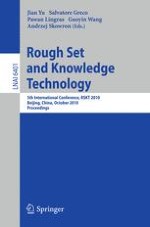TheInternationalConferenceonRoughSetandKnowledgeTechnology(RSKT) has been held every year since 2006. RSKT serves as a major forum that brings researchers and industry practitioners together to discuss and deliberate on fundamental issues of knowledge processing and management and knowled- intensive practical solutions in the current knowledge age. Experts from around the world meet to present state-of-the-art scienti?c results, to nurture academic and industrial interaction, and to promote collaborative research in rough sets and knowledge technology. The ?rst RSKT was held in Chongqing, China, f- lowed by RSKT 2007 in Toronto, Canada, RSKT 2008 in Chengdu, China and RSKT 2009 in Gold Coast, Australia. RSKT 2010, the 5th in the series, was held in Beijing, China, October 15–17, 2010. This volume contains 98 papers selected for presentation at RSKT 2010. Following the success of the previous conferences, RSKT 2010 continued the tradition of a very rigorous reviewing process. Every submission was reviewed byatleasttworeviewers.Moreover,RSKT2010invitedseveralareachairsto- pervise the review process of every submission. Most submissions were reviewed by three experts. The Program Committee members were deeply involved in a highly engaging selection process with discussions among reviewers and area chairs. When necessary, additional expert reviews were sought. As a result, only top-quality papers were chosen for presentation at the conference, including 49 regular papers (acceptance rate of 28%) and 25 short papers (acceptance rate of 14.3%). We would like to thank all the authors for contributing their best papers. Without their support, this conference would not have been possible.
